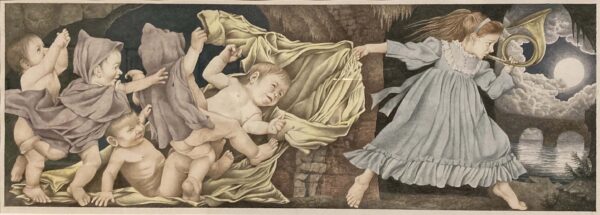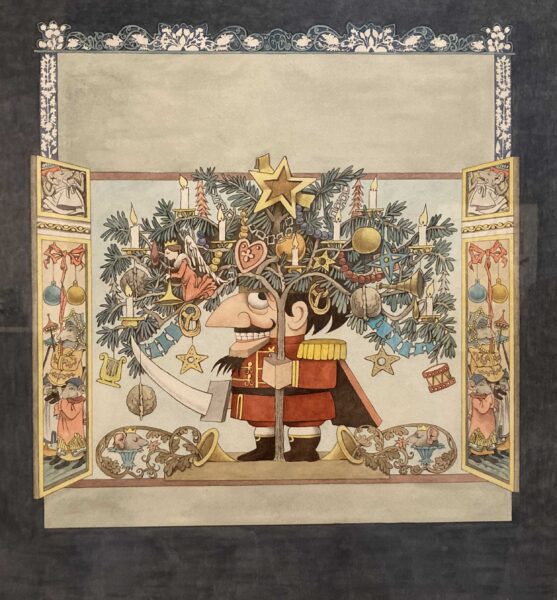“Wild Things Are Happening, the Art of Maurice Sendak” at the Skirball Cultural Center (April 18-September 1) must be seen and experienced.

Skirball Director Sheri Bernstein stated: “This is the largest and most comprehensive exhibition of the artist’s work to date. It tells an expansive story of his family upbringing (Sendak was born in Brooklyn, New York to Polish immigrants), his extraordinary gift as a storyteller, who brought emotionally powerful stories to life using word and imagery, it looks at his Jewish identity and his artistic influences.”
I first became aware of Maurice Sendak as a new mother, when a Jewish friend gifted me the 25th anniversary edition of his landmark 1963 book Where the Wild Things Are (still displayed on one of my many bookshelves with other children literature), and I recently gifted another copy to my toddler grandchild.

At the press preview I was lucky enough to speak with Dr. Jonathan Weinberg, curator of the Maurice Sendak Foundation, a painter and author of books about artists, and he explained that this exhibit wants to emphasize what a remarkable artist Sendak is.
His work extends well beyond his most celebrated children’s book, Where the Wild Things Are, and the other two books of his self-proclaimed trilogy, In the Night Kitchen (1970) and Outside Over There (1981).

Weinberg said that Sendak considered himself an illustrator, but then he would say that Michelangelo was an illustrator as well, when he painted the ceiling of the Sistine Chapel.
He designed sets, costumes, and poster art for several ballet and opera productions, such as The Magic Flute by Wolfgang Amadeus Mozart, directed by Frank Corsaro for Houston Grand Opera in 1981, Tchaikovsky’s Nutcracker choreographed by Kent Stowell at Seattle’s Pacific Northwest Ballet in 1983.

In 1988 Sendak was invited by Robert Redford to become artistic director of the Sundance Children Theater.
For years, he designed posters for the festival New York Is Book Country, and while they usually featured Wild Things, in the one for 2003 he paid homage to the rescue workers of 9/11.


In 1996 Sendak created an advertising campaign for Bell Atlantic titled “Wild Things Are Happening.”

Weinberg observed that Sendak was a great believer in collaboration with other artists, worked with Spike Jonze on his 2009 live-action movie of Where the Wild Things Are, with composer Oliver Knussen on operas of Where the Wild Things Are and Higglety Pigglety Pop! performed as a double bill with Higglety Pigglety Pop! at the Glyndebourne Opera in England in 1985.

Weinberg added that Sendak was connected with other counter-cultural figurative artists of that time, working in New York’s Greenwich Village in the 1950s and 60s, who were actually his friends: Jules Feiffer, Edward Gorey, Tomi Ungerer.
Despite his reputation for being cantankerous, Weinberg, who knew him personally, maintains that Sendak was warm and charismatic, had a hilarious sense of humor a la Mel Brooks, and everybody fell in love with him, as did Steven Colbert when he interviewed him at his home in Ridgefield, Connecticut, in January 2012 a few month before his death at 83.

Sendak was a gay man, living with his partner of fifty years, psychiatrist Eugene Glynn. The two men were devoted dog owners. Sendak wrote Higglety Pigglety Pop! or There Must Be More to Life (1967) about his first dog Jennie, illustrated a comic-strip dog training manual, Some Swell Pup; or Are You Sure You Want a Dog?
Sendak was an atheist, Weinberg clarified, “a secular Jew, he felt that his ethnicity was essential to who he was and he could not imagine not being connected to Judaism, but he was certainly very critical of established religion.” He was inspired by other artists, like Mozart, Herman Melville, William Blake, “when he’s in trouble he goes to them as a way to find his voice.”

I was also inspired by walking through this amazing exhibit and at the end I sat in the Reading room and read Outside Over There, about a little girl rescuing her baby sister from goblins.
You may click on words underlined in orange for links to more info.


